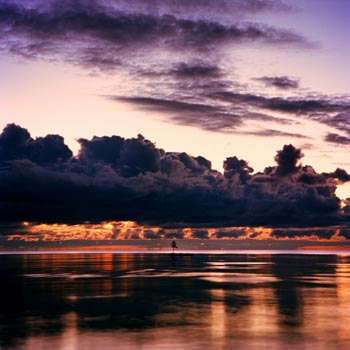
Kunsthallen Brandts Brandts Torv 1 DK-5000 Odense C Danemark
The dream – or fear – of being stranded on a desert island can now be experienced at Kunsthallen Brandts. The exhibition I-LANDS examines the island concept from six different angles, moving between the extremes of imprisonment and freedom.
Desert islands have fascinated numerous artists, writers and filmmakers. Many works have as their origin Daniel Defoe's 18th-century novel Robinson Crusoe which describes the consequences of spiritual and social isolation. Only one thing is worse than being stranded on a desert island alone, and that is being stranded with a group, as revealed in William Golding's novel Lord of the Flies.
The opposite – the island conceived as paradise regained – has likewise served as a source of inspiration. While Paul Gaugin's paintings from Tahiti can make us wish ourselves far away from CO2 quotas to life on a white beach under the shade of palm trees, a sinister version of this is the painter Arnold Böcklin's Island of the Dead. Islands have not lost their attraction. Some of the most talked-about reality shows on TV have islands as their beautiful setting and are about survival. While the aim of the game in a series such as Robinson is to become the island's sole inhabitant by behaving egotistically and forming alliances, in Paradise Hotel the idea of a harmonious island paradise has given way to exhibitionism, drunkenness and sexual excess. From John Donne's statement that "No man is an island" we have developed to the point of being wholly self-sufficient – preferably with an admiring audience.
Artists in I-LANDS
Kunsthallen Brandts has invited six contemporary artists who have used islands as symbols of our ethical and moral attitudes now and in the past.
Ross Sinclair (Scotland) takes us to the extreme limit of goodness in his installation Journey to the Edge of the World. Two films by this artist depict the island of St. Kilda in the Hebrides where for centuries descendants of Norwegian Vikings lived in a time pocket. In the 1850s, the community was discovered by civilization and brought to ruin in the course of two generations.
The Finnish artist Antti Laitinen shows It's My Island, a work in which photos and videos document his painstaking efforts to realize his dream of an island of his own. Hundreds of bags of sand and a tree make up his small kingdom which he must finally witness being swallowed by the sea.
An island as the perfect place to keep criminals is depicted in a work by Bill Burns (Canada). He has built a watchtower from which to detect possible escaping prisoners. Interested visitors can get to stay in a prison cell and listen to torture music.
The installation Alterations by Amy Cutlers (USA), consisting of no less than 120 female figures, looks like a gigantic, island council except for the fact that these figures seem strangely agreed upon keeping up their mysterious undertaking involving a complicated version of Cat's Cradle.
The three islands by Andreas Schulenburg (Denmark) are not only deserted, they are also soft, and perhaps the use of felt is precisely what makes these sculptures so humorous.
Life on desert islands is not all idyllic. The idea of islands as places where natives live in harmony with animals and plants, or engage in cannibalism, is examined by Tim Silver (Australia) in his photo series The Tuvaluan Project.

